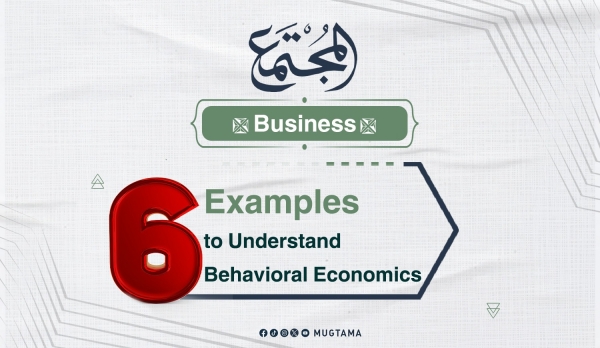Despite the multiple traditional economic theories that assume humans are rational and seek to maximize profit and utility, behavioral economics assumes otherwise. Emotions, cognitive biases, and psychological factors play a significant role in shaping individuals' behavior across various sectors. Behavioral economics integrates principles of psychology and economics to understand how individuals, financial institutions, and companies make financial and economic decisions.
Behavioral economics has been applied in several fields, such as designing economic policies, analyzing consumer behavior, and investing in financial markets. Consequently, it helps improve and develop marketing strategies, enhances savings, and reduces the gap between individuals' actual behaviors and economic expectations. Therefore, companies and governments have relied on the principles of this type of economics to guide individuals’ behavior positively, using nudging techniques such as offering incentives in a psychologically effective manner.
From this perspective, behavioral economics sheds light on the human aspect of economics, making it a powerful tool for understanding and improving everyday economic decisions.
In 2007, the price of an iPhone with 8GB of storage was $600. The company was fully aware that this price was higher than the normal market rate. However, it quickly lowered the price to $400 because it understood that if the price had been $400 from the start, the market reaction might have been negative. Instead, consumers perceived the price drop as an unmissable deal, leading to a surge in sales of that version.
The Importance of Behavioral Economics
Behavioral economics is highly concerned with explaining individuals' and companies' behavior, analyzing labor market dynamics, and uncovering the hidden motivations, biases, and factors behind economic decisions. This understanding helps policymakers and analysts implement more effective policies and procedures to regulate markets, improve governance, and drive economic development.
Behavioral Economics and Understanding Consumer Behavior
All businesses today must accurately target their audience to succeed. After that, they need to analyze audience behavior and identify the motivations behind it. Here, behavioral economics plays a crucial role in understanding the audience better, determining the best ways to influence them, and ultimately impacting the market and economy as a whole. This is achieved by focusing on purchasing intentions, cultural dimensions, psychological factors, and cognitive biases. Understanding consumer behavior and effectively investing in it leads to increased customer satisfaction, which in turn boosts sales and revenue.
Behavioral Economics and Analyzing Corporate and Institutional Behavior
Any company or institution aiming for competitive superiority must be capable of understanding the behavior of its customers and partners to make intelligent production decisions. Behavioral economic models focus on studying the social and psychological factors that influence corporate economic decisions. Instead of assuming that companies act purely rationally, these models consider cognitive biases and psychological reservations that may impact production decisions.
Behavioral Economics, Competitive Advantage, and Innovation for Companies
As previously mentioned, behavioral economics enables companies to analyze consumer and competitor behavior, anticipate future market trends, and understand how to encourage consumers to make purchasing decisions. Applying this type of economics can drive innovation, help develop unique products, and create a competitive advantage by understanding consumer and producer behavior. It also assists in identifying strengths and weaknesses in the target market, leading to the development of competitive strategies that contribute to company growth and increased revenue.
Behavioral Economics and Government Economic Decision-Making
Behavioral economics is not limited to private sector institutions and companies. It also plays a crucial role in public economic decision-making at the state and governmental levels. It helps analyze economic policies, assess their impact, and focus on the psychological and social interactions influencing individual and group decisions. This knowledge allows governments to design effective economic policies that achieve national goals and improve overall societal well-being.
Want to Double Your Success and Boost Your Profits?
Of course, you want to increase your success and enhance your profits. But numbers alone are not enough!
You likely use data and figures to achieve your goals and grow your business. That makes sense, as numbers provide accurate, measurable, and trackable indicators. However, these figures only cover limited aspects. Behavioral economics reveals what numbers do not—it explains the reasons and motivations behind the data: How did they come about? Why did they appear in these proportions? And how can they be altered or enhanced? It focuses on the why behind the what (numbers).
Six Examples for Understanding Behavioral Economics
By now, the concept of behavioral economics is clear, but here are six real-world examples to deepen the understanding of how it is applied:
1. Free Trial Offers – The strategy of "Get this product for free for a limited time" is based on a psychological principle: loss aversion. It makes consumers feel they will miss out if they don’t take the offer.
2. Exploiting Mental Accounting Bias – Ending a price with ".99" tricks the brain into perceiving a lower price.
3. Using Scarcity Strategy – Phrases like "This offer is available for a limited time" make the brain perceive urgency, prompting immediate purchasing decisions.
4. Social Proof – Consumers tend to trust and buy products that appear to be widely approved by others.
5. Loss Aversion – People fear losses more than they enjoy equivalent gains. The pain of losing something outweighs the pleasure of gaining something of equal value.
6. Framing Effect – Consumers are more influenced by how information is presented than by the product itself.
These examples illustrate that behavioral economics focuses on aspects that traditional economics often overlooks. It assumes that psychological factors play a significant role in shaping consumer behavior, and companies and institutions must consider these factors to attract more customers and increase their sales and revenue.
-------------------------------------------------------------
1- Ahmed Hassan Al-Najjar, Behavioral Economics and Its Global Applications: 40 Behavioral Experiments Around the World - 8 Diverse Sectors. Saudi Arabia, Obeikan, 2019.
2- Amr Ahmed Abdel-Malek, Fundamentals of Behavioral Economics. United Arab Emirates, Emirates Center for Strategic Studies and Research, 2020.
3- https://thefintechtimes.com/behavioural-economics/
4- https://jliedu.ch/the-need-and-relevance-of-behavioral-economics/.


